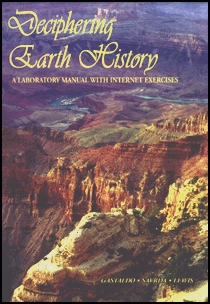
|
Deciphering Earth History: A Laboratory Manual with Internet ExercisesISBN 0-89892-139-2 "The past may not repeat itself,but it does rhyme."Mark Twain |
As Earth scientists learn more about the way in
which our
planet
functions, we find that the decoded patterns of Earth history illustrate
Mark Twains proverb. The patterns of Earth history may not be exactly the
same time after time, but these patterns are very similar in many
respects. Our understanding of these trends and their variation through
time comes directly from the stratigraphic record. This laboratory
manual, written for introductory Historical Geology courses at the
university-level, covers the basic principles used by geologists and other
Earth scientists to interpret the stratigraphic record. Unlike other
Historical Geology manuals, this book provides a wider coverage of more
topics, techniques, and applications. We have tried, where possible, to
present exercises that incorporate information from several different
geological areas. This is because no single area of geology can explain
what we can document in Earths past. It is necessary to use several
different approaches to understand our planets past. Four and a half
BILLION years of history arent easy to explain using one or even two
isolated approaches. Many exercises are based upon real data, allowing
you to follow the lines of reasoning and logic used to decipher Earths
saga. Where possible, we also have used analogies to help you appreciate
the parallels between how Earth operates today and how it operated in the
deep past. Deciphering Earth History consists of exercises that are
both
traditional and contemporary in approach. Traditional exercises provide
the foundations of our reading of Earth history, while contemporary
approaches include small projects designed to demonstrate the trends on
Earth over long intervals of time. As we face uncertainties about future
global climate change and the response of ecosystems to this change, the
recent and deep past provide models of ancient (and not so ancient)
responses to similar trends. These data are found both in the biological
(monerans, protists, fungi, plants, and animals) and abiological systems
(for example, sedimentology and geochemistry, stratigraphy and
radioisotopes, tectonics and geophysics). In the development of these
exercises and overall goals of the manual, we have not relied upon any one
approach to introduce the concepts. Rather, we have drawn from all
available examples to demonstrate that Earth and its components are a
unified whole. So, whats new? Responding to colleagues who adopted the
previous
versions of this manual, we have rewritten and changed much of the text in
the Introductory materials and the exercises, presenting complex concepts
in more simplified terminology. Answers to some of the questions in the
exercises have been changed, allowing for easier identification of the
correct answer, reducing any ambiguity. Some exercises have been
shortened to allow for their completion under limited laboratory time;
however, instructors still have the option of picking-and-choosing
portions of labs to fit the laboratory-time allotment. New line drawings
have been added to clarify concepts, and eight pages of color images
appear early in the book demonstrating the basic sedimentary rock types
(clastic, chemical, organic, and volcanogenic), the primary
sedimentological structures most commonly found in the rock record, and
the environments in which both the rocks and structures form. These color
figures are referenced where appropriate in the text, allowing for you to
visualize the concepts introduced in the exercises; the Appendix still
provides a paleobiological overview of the major animal and plant groups
commonly fossilized. The mathematics behind radioisotopic calculations now
are included and an exercise has been provided to apply this technique.
Internet exercises that were once separate worksheets in the back of the
manual have been incorporated, where appropriate, as supplemental
exercises within chapters. Its still tough to get collections of Burgess
Shale fauna for laboratory, allowing for web surfing. Some of the old
internet exercises have been changed, others omitted. The exercise on
Plate Tectonics has been converted from internet-based to hard-copy based
(Exercise 16) and appears following the Geologic Map exercise (Exercise
15). Overall, this edition of Deciphering Earth History may
not have repeated itself, but it sure does rhyme.
The 3rd Edition of Deciphering Earth History - rewritten, revised, and expanded - is now available. For Information contact:
Contemporary Publishing Company of Raleigh, N.C.3rd Edition Updated Internet Links
